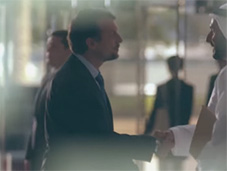The media industry loves its buzzwords, and ‘programmatic’ is one buzzing all over the place. But what does it mean and why should you care? It means no more compromises. It means receiving content that is specifically targeted and produced just for you. However, for every one person that may think that it sounds great, I can find you two who call it scary.
I think it sounds like a lot of work. Content that can be targeted to a very specific demographic makes sense. But how do you go about doing that with video?
While attending this years’ National Association of Broadcasters Convention (NAB) in the US, I heard some amazing case studies of how the American market is taking the programmatic approach to the next level through video.
Take Toyota for example. They were keen on ensuring that video ads for their new RAV4 Hybrid resonated with their target audience and their personal interests.
How did they do that? Create a different video that would appeal to everyone. This personalized approach resulted in Toyota creating 100 versions of the same video. Yes, you read that right—100 versions of the same video.
Their next move was to loop in a celebrity name—actor James Marsden in this case, who brought in a je ne sais quoi to the campaign.
This is where things get interesting. Depending on what a certain individual liked, say on Facebook, he or she got served the relevant video. Say that you happened to like hiking, Marsden surely would as well with the ad focused on hikers and trekkers popping on your feed. If technology was more your thing, fear not as Marsden had covered that too.
From a production standpoint, this was no mean feat. Each video was divided into three short scenes. The opening sequence, which is an introduction to the product. The midsection, which highlights a feature correlating to the ‘likes’, or preferences and the final section, which incorporates humor.
Filming a range of scenes for each of the three sections, Toyota ended up with almost a 100,000 possible video combinations. And these were all green screen videos, which kept costs low. Based on information shared at NAB, the entire video campaign only cost $160,000. Now that’s value for money, given that it outperformed 90% of all Facebook campaigns.
Toyota effectively saved a few million, created a smart campaign and connected with its audience on a much more personal level than traditional advertising could have allowed them—with this programmatic approach. How long will it take before we see such campaigns in this region?
It’s probably already happening right under our noses.
As I was in the airport on my way back home to Dubai, I stopped in at the newsagent in the terminal and scoured the magazine shelves for reading material and spotted the current edition of Inc. with someone I didn’t recognize on the cover.
I happened, to flick past that copy and right behind it found what seemed to be an entirely different edition of Inc., only with Michelle Phan (American YouTube star) on the cover, someone I was interested in. Inc. had smartly printed different runs of the magazine with different entrepreneurs on the cover.
They closed a sale with me because they understood that people pay attention to what they’re interested in and what people pay attention to can be many different things.
Definitely food for thought when you’re planning your next campaign, video or no video.
